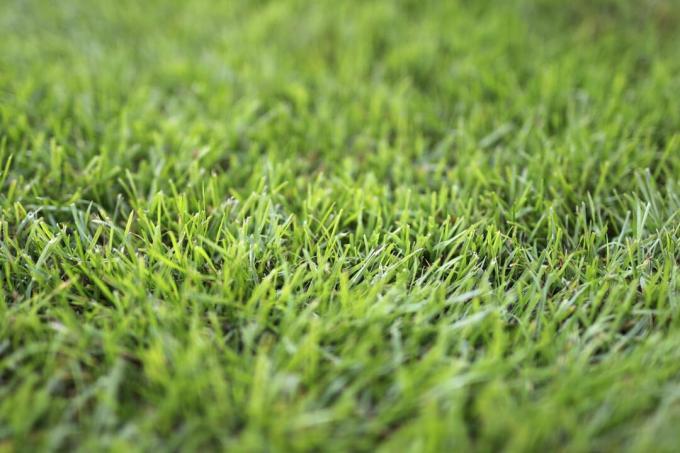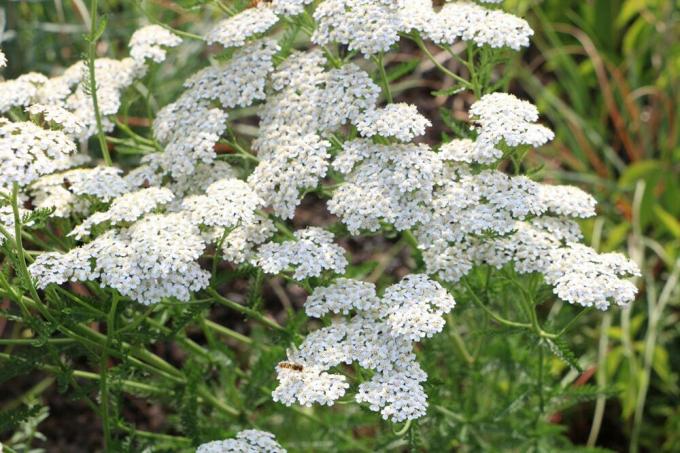

Table of contents
- millet
- Prevent
- Removed
- scarify
- Other countermeasures
- Accept
- Conclusion
- Worth knowing about millet in the lawn
- Ways of combating millet in the lawn
- More lawn weeds - different control options
- Weed control of lawn weeds by herbicides
Weed grasses, which attract attention with their thick, unsightly clumps, can best be kept in check by good lawn care and a turf that is as dense as possible. Millet in the lawn can be easily removed manually in smaller areas. For larger areas it may be necessary to chemically combat and destroy millet. As a heat-loving grass, it has worked its way out of the south over the course of time and is now native to Germany. Counteracting this with chemicals should always be the last resort.
millet
Millet is the oldest grain and still serves as a valuable food source in many countries today. Millet is one of the sweet grasses (Poaceae). Among the species that are a thorn in the side of professional farmers and hobby gardeners are mostly wild forms of cultivated millet (
Panicum miliaceum subsp. miliaceum), the loggerhead weed millet (Panicum miliaceum subsp. agricultural) and the weed millet (Panicum miliaceum subsp. ruderal). Undisturbed, they can reach a height of up to one meter. This species of grass is annual, self-pollinating and reproduces only by seed. In order to germinate, they need permanent temperatures above 20°C. Millet is very fertile and grows rapidly.Millet usually finds its way into home gardens via soil fillings. It is a classic weed in vineyards and corn fields. A lawn seed contaminated with millet seed is very unlikely. New lawns and bare patches in the lawn are particularly susceptible to millet. Millet grasses need a lot of light and warmth for their growth.
Prevent
The weed millet also only thrives under good conditions. It needs light, warmth and space. A well-tended lawn, densely grown, can make it difficult for millet to assert itself. Bald spots in the lawn should therefore be filled with new lawn seed as quickly as possible. Sufficient water and nutrients for the lawn are also part of the precaution against weeds and for a healthy turf. Repeated reseeding with grass seed will result in a denser and denser lawn over time. For this purpose, there are extra fast-germinating seeds in specialist shops.
Fall is an ideal time to plant a new lawn. It is then too cool for millet to germinate. If gaps are found in the following spring, it is important to fill them in again as quickly and early as possible with overseeding. After sowing, you should fertilize with a long-term fertilizer for lawns. Although this also strengthens any weeds that may be present, it is important for the assertiveness of the desired blades of grass.
Removed
If annoying grass shoots up out of the lawn in May, then it can't be millet. Millet grasses need a few warm days and constantly warm soil before they germinate at all. So they won't be visible until the end of May. If the summer is hot and dry, the millet finds optimal survival conditions, while the grass only grows sparsely. Annual millet is in a hurry to multiply. It therefore begins to sow the next generation soon after germination, already in June after a short flowering period. If the temperatures then drop to 15 °C in autumn, the grasses turn brown and die. If you then discover a few millet in the grass in June, it is best to lend a hand right away. Anyone who can pull out or prick the clumps in June, before flowering, has already won the battle. Since millet does not have deep roots, this is quite easy to do.
scarify
If the infestation is large, it is worth scarifying the lawn flat. The best time for this is a summer day that is not too hot and dry. By scarifying the millet stalks straighten up and can be mowed. If necessary, you can then overseed the cleared areas.
Other countermeasures
Applying herbicides to lawns is difficult. Because the toxins against weed grasses usually make no difference between good and unwanted grasses. In the case of stubborn millet problems and larger lawns, treatment with herbicides may be necessary.
- forward agent
- post-emergence agent
An existing lawn with stubborn millet growth can be treated with a preliminary agent. Millet that has already emerged must be combated at an early stage, preferably in April. This prevents flowering and seed formation. After tillering (branching) it is difficult to combat with the usual means. The lawn is treated with a so-called pre-run herbicide early in April. This herbicide is taken up by millet through its upper and lower parts of the plant and stops its growth. Before and after applying the herbicide, no new or overseeding may take place. At least until the 4th Cut.

If the millet has already emerged, there are herbicides for post-emergence. This should be applied as early as possible, before flowering and the formation of side shoots. Treatment usually takes place between May and August. If the product is evenly distributed on the lawn, it should not rain for at least 6 hours afterwards. So check the weather forecast in advance. For heavily infested areas, a second treatment may be necessary after 1-2 weeks.
Tip:
If you can't avoid using a herbicide, you shouldn't just buy it in a discounter or hardware store. In specialist shops you can get advice on the right product and tips for effective use.
Accept
Even if you stop fighting something, you can still win. Lawns are actually monocultures, so they will always be sensitive to wild grasses and other weeds. Nature strives for the greatest possible diversity of species. So if you don't value an even lawn, or are dependent on it, you can consider giving up the fight. Grasses such as millet make the hay valuable for compost and small livestock. If you can get used to a natural meadow, you will have significantly less worry and work with your lawn, no, your meadow.
Conclusion
The most effective way to achieve a single-variety lawn is to manually remove germinating millet grass before it blooms. The use of herbicides is only worthwhile in the case of large-scale, heavy infestations. The use of chemicals not only pollutes the environment, it is also quite costly and labor intensive.
Worth knowing about millet in the lawn
Ways of combating millet in the lawn
- In order to prevent the millet from germinating, the new sowing should be done with a long-term fertilizer be treated.
- This strengthens the new lawn and makes it more resistant to unwanted millet weeds.
- The flat-growing millet plants are also directed through the lawn fertilizer and can therefore be mown or weeded more easily.
- Weeding is the most effective and effective method of combating millet.
- The formation of millet seeds should be avoided as far as possible, as they cannot be removed from the lawn.
- In addition, the seed survives in the soil and multiplies in this way.
- Scarifying is another way to curb millet growth.
- This is achieved by scarifying the lawn flat weed raised and can therefore be mowed much more easily.
- The lawn is then strengthened with fertilizer and at the same time stimulated to grow healthy and dense.
- Millet is an annual plant, prefers a soil temperature of around 20 °C and consequently dies back in autumn.
- In order to close any gaps in the turf, the lawn is sown again from mid-April to the beginning of May.
More lawn weeds - different control options
- Also weeds like clover, dandelion, goutweed or moss can severely prevent lawns from growing healthily.
- A well-kept lawn, golf course or ornamental lawn requires intensive care through regular watering, scarifying and fertilizing.
- Liming can also neutralize acidic soil and thereby counteract the formation of moss in particular.
- Most weeds do not tolerate constant pruning, so regular pruning is also part of it lawn clippings for effective weed killing.
- Scarifying removes herbs and thatch so that the lawn is again supplied with sufficient light and oxygen.
- Girdweed and dandelions are best removed with a weed puller.
- Care should be taken to remove the roots completely so that the plants cannot grow back.
Weed control of lawn weeds by herbicides
- If lawns are already infested with weeds over a large area, natural pesticides will no longer help in most cases.
- Then the use of special herbicides against weeds and grass weeds can bring the lawn back into shape.
- Foliar herbicides have an extensive spectrum of activity against stubborn herbs.
- The chemical weed killers work from the plants above ground to the roots.
- Weed herbicides are also useful for preparing the Lawn New seed. There are also combined weed killers and lawn fertilizers.
- Thanks to the nutrient supply and simultaneous weed control, any gaps in the lawn can be quickly closed again.
 garden editorial
garden editorial I write about everything that interests me in my garden.
Learn more about lawn care

Sanding the lawn: how much sand per m²?
The lawn is the focal point of the garden. Sanding the lawn can effectively influence its appearance. However, there are a few things to consider, because too much of it can also damage the green. Read here how much sand you should apply per m² when sanding the lawn.

Overseed the lawn without scarifying?
Which hobby gardener doesn't dream of a dense, lush green lawn? Bald spots not only look unsightly, they also encourage weed growth. But can you overseed a lawn without scarifying it first?

Recognize and fight couch grass successfully | 10 tips
Couch grass is one of the most stubborn weeds. However, there are also differences here, because not every species becomes a problem in the garden. However, if the creeping or common couch grass is up to mischief, you can take action against it with perseverance and the right techniques.

Iron fertilizer: the right use in the lawn
Iron fertilizer supplies the lawn and works against moss. However, it has to be used correctly. Therefore, observe the following tips to achieve optimal results for the grass plants and to avoid damage to the meadow.

Does coffee grounds help against clover in the lawn?
Clover in the lawn is a nuisance that many garden owners struggle with. Lawns, which in some cases are interspersed with numerous nests, are often affected. As an alternative to chemical agents, many wonder whether coffee grounds are effective against weeds.

Yarrow in the lawn | How do I get rid of yarrow?
There is no question that yarrow is one of the best-known medicinal herbs. It helps against colds and is used for skin diseases and gynecological problems. On the manicured lawn, she is seen as a troublemaker. How do you get rid of them? Are there effective alternatives to the chemical club?



